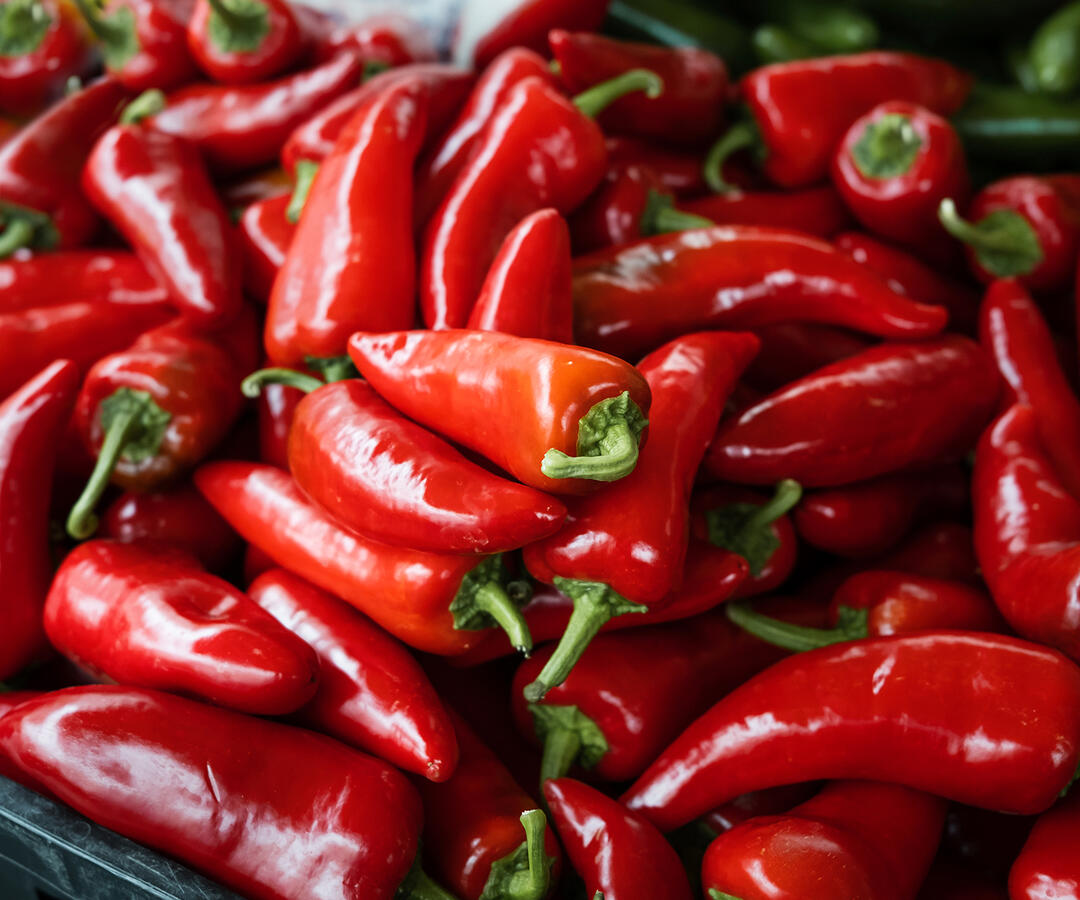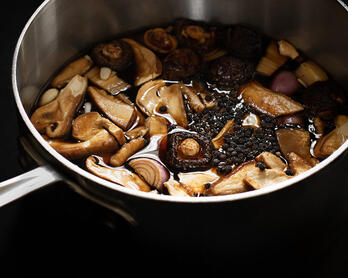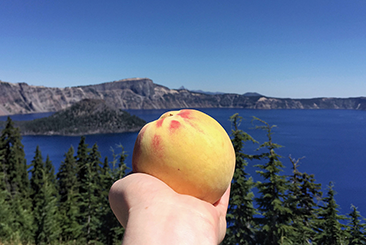Spicy Pepper Soy Sauce

The best time to buy peppers was two months ago. The second best time is now. - Solanaceae Wisdom
Peppers are strongly associated with greater happiness so my aim is to add them to as many meals as possible. After picking up some galbi (Korean short ribs) from A Cut Above Butcher, my condiment quest led me to Korean Vegan’s Spicy Soy Sauce. It’s an umami bath that's chock-a-block with peppers, more peppers, and aromatics, and wants to be generously spooned over everything from herbed rice to meat.
Though I'm still green when it comes to Korean cuisine, Spicy Soy Sauce seems to be a mashup of soy pickled vegetables (jangajji) and a relatively common seasoning sauce. The latter generally includes soy sauce, rice vinegar, sesame, gochugaru (Korean chile flakes), garlic, and scallions. The beauty of the union is that the soy sauce marinates the peppers and in return the peppers share their fruity notes and heat. The flavor improves with age and a batch can be frozen for when peppers wilt off into the sunset. Always sad to see chiles go but the thrill of anticipation will propel me into the 2023 season.
Around The Dinner Table
Ongoing Education
I've been making an effort over the last many months to build a core East Asian pantry, reaching into Southeast Asia for flavors from Thailand. It's an ongoing education that is steadily making my cooking more delicious.
A few foundational Korean ingredients that made it through the door early are the jangs - gochujang (fermented pepper paste), doenjang (fermented soybean paste), and ganjang (light soy sauce that's actually saltier than dark). I took to gochujang right away and am already working through my third jar. It's a versatile staple even if you have little interest in making Korean food.
Traditionally, gochujang is a minimalist list of ingredients that are aged in a clay pot and transformed by sunshine and time. The fermentation imparts the depth of umami along with a gentle sweetness and heat that's meaningful but not dominant. Gochujang hits all the notes. Apparently some brands are very spicy but I didn't encounter that.
I've come to think of gochujang like Korean ketchup more because of its versatility than a desire to put it on hot dogs. It's also worth noting that the paste is a component rather than a standalone condiment. The other week I needed a quick sauce for tacos so I combined homemade mayonaisse and gochujang and it turned out to be an unexpectadly outstanding pairing. Before tomatoes leave the scene the goal is to use my jang mayo on a BLT. Come to think of it, gochujang mayo would probably be good on hot dogs.
In terms of brands, I started with Jookjangyeon which is made in the traditional style and has a deep red color and thick consistency. The second brand was Mother In Law's which has more ingredients and a looser consistency. The difference is akin to a tomato paste that's a difference maker vs. a grocery-store tomato paste that does an adequate job. They both work but if budget allows I'm opting for the difference maker and that honor goes to Jookjangyeon. Gochujang is worthy of being an investment ingredient.
DIY
For the fermentation fans in the room, I found a recipe with 28k reviews that looks like a good outline for what is a relatively easy process (and more economical that the artisinal brand mentioned above). Similar to Preserved Lemons, Limes, and Kumquats, the only "hard" part is having patience. At some point I hope to give it a go but plan to cut the recipe down and possibly buy dried Korean chile peppers to grind. Definitely looks like a fun project.
Original vs. Adapted
Mix-and-Match
I increased the pepper quantity (of course) and used more varieties than is really necessary. I squirrel away every kind of pepper at this time of year so each of my Spicy Soy Sauce batches have included a little of this and that. You only need two types of peppers (though three would be excellent) so work with what you have and focus on balancing the mild and hot. The goal is to keep the ratio of umami bath to vegetables roughly on target.
Acid
My adapted version includes lemon juice. I'm always on the lookout for dishes that will benefit from citrus and find that lemon plays especially well with soy sauce (and stir fries for what it's worth).
Gochujang
I reduced the gochugaru slightly in order to incorporate the gochujang.
Recipe Tips
Keep It Spicy (or Not)
On the pepper variety note, it's easy to dial the spice up or down to meet your preference. I lean into heat and include a higher proportion of hot peppers since the soy sauce (i.e. pickling) tends to tame the capsaicin.
Scallions
If I'm not planning to use or freeze the sauce within 3 to 4 days of making it, I leave the scallions out until the day before I plan to serve. Scallions can get a bit funky when left to swim around for too long, hence the fussy step.
Substitutions
I haven't tried these substitutions but this would be my approach if I came up short on an ingredient.
- Gochugaru (Korean chile flakes) - My first choice would be to increase the gochujang. If that wasn't available, then Aleppo pepper might work since it has a nice tang and heat. Red pepper flakes are one-dimentional and the heat is specific so they would be my last choice.
- Gochujang - Increase the gochugaru by 1/2 teaspoon if you don't have gochujang.
- Rice Vinegar - I use brown rice vinegar because I happen to have it in the pantry. White rice vinegar is a fine substitute.
Farmers | Artisans
I make an effort to source my food from California artisans with a special focus on the Santa Monica Farmers Market. Below is a list of the folks who contributed to this dish.
- Tutti Frutti Farms // Peppers
- Belyik Farms // Peppers
- Weiser Family Farms // Peppers
- Finley Farms // Peppers
- Polito Family Farms // Citrus
- Windrose Farms // Garlic

Fresno Chiles - Santa Monica Farmers Market
Ingredients (Adpated from Korean Vegan)
Sauce Base
- 1/2 cup soy sauce Note: See Recipe Tips
- 2 1/2 teaspoons gochugaru (Korean chili flakes)
- 2 teaspoons gochujang
- 2 cloves garlic, minced
- 1 tablespoon + 1 teaspoon brown rice syrup or honey Note: I opt for honey.
- 1 1/2 tablespoons white or brown rice vinegar Note: I use brown.
- 1 1/2 tablespoons mirin
- 2 tablespoons fresh lemon juice
- 1 1/2 teaspoons freshly ground black pepper
- (Optional) 1/4 teaspoon ground turmeric
Vegetables
- 2 tablespoons red onion, small chop
- 2 jalapeño peppers, small chop
- 2 Padron peppers, small chop
- 1 Fresno pepper, small chop
- 2 Jimmy Nardello peppers, small chop
- 1 Calabrian chile, small chop
- 1/4 cup scallions (greens and light greens) Note: See Recipe Tips
Instructions
- Combine the sauce base ingredients and whisk to thoroughly combine.
- Add the vegetables, stir, then refrigerate in an airtight container for at least a day before serving. The cookbook suggests it lasts for a month but mine is usually gone within a week.
Serving
- This sauce gets better with age and ideally should be made a couple of days in advance.
- The chile flakes settle to the bottom so stir the sauce thoroughly before serving.
Newsletter
Subscribe at the bottom of this page for the Chic Eats roundup. It includes new and updated recipes along with a grab bag of unique content that was interesting enough to share around the dinner table.






